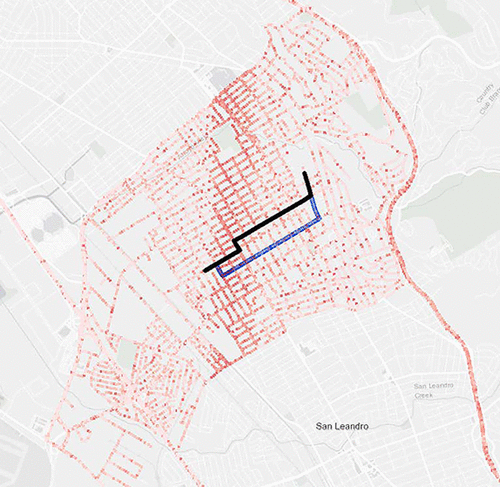当前位置:
X-MOL 学术
›
ACS ES&T Eng.
›
论文详情
Our official English website, www.x-mol.net, welcomes your
feedback! (Note: you will need to create a separate account there.)
Using Big Data Techniques to Better Understand High-Resolution Cumulative Exposure Assessment of Traffic-Related Air Pollution
ACS ES&T Engineering ( IF 7.4 ) Pub Date : 2020-12-15 , DOI: 10.1021/acsestengg.0c00167 Minmeng Tang 1 , Deb A. Niemeier 2
ACS ES&T Engineering ( IF 7.4 ) Pub Date : 2020-12-15 , DOI: 10.1021/acsestengg.0c00167 Minmeng Tang 1 , Deb A. Niemeier 2
Affiliation

|
In this paper, we calculate exposure concentrations of traffic-related air pollutants for different travel modes in the urban environment. Using recent high-resolution mobile sensor measured air pollution concentration data, we simulate bicycle, transit, and vehicle trips within Oakland, California and calculate exposure concentrations for nitric oxide (NO), nitrogen dioxide (NO2), and black carbon (BC). We draw on highly resolved sensor data (on the order of seconds) collected by Aclima and Google, which was then aggregated to the annual median for every 30-m road segment in the study area of Apte et al. For each bicycle, transit, and vehicle trip that we simulate, we calculate the average concentration and the cumulative exposure for all three pollutants. The cumulative exposure is calculated as the total mass of pollutants inhaled during a trip. Our results show that cumulative exposure, rather than the more typical average ambient concentration, may be a better metric for assessing travel pollutant exposure. For all three travel modes, the average concentrations of each trip are not significantly different. When we account for trip duration and route variations for different travel modes and inhalation rates, the cumulative exposure varies dramatically. Cumulative exposure for vehicle passengers tends to be the lowest, as well as having the lowest average per meter and per minute exposure. Bicyclists and public transit users tend to experience higher cumulative exposure due to increased inhalation rates for bicyclists and longer trip duration for public transit users. Last but not least, our study shows that total trip duration is more influential than total trip distance when estimating air pollution exposure. Our use of big data and modern simulation techniques point toward better metrics for assessing air pollutant exposure.
中文翻译:

利用大数据技术更好地了解与交通相关的空气污染的高分辨率累积暴露评估
在本文中,我们计算了城市环境中不同出行方式下与交通有关的空气污染物的暴露浓度。使用最新的高分辨率移动传感器测量的空气污染浓度数据,我们可以模拟加利福尼亚州奥克兰市内的自行车,公交和车辆出行,并计算一氧化氮(NO),二氧化氮(NO 2)和黑碳(BC)。我们利用由Aclima和Google收集的高度解析的传感器数据(以秒为单位),然后将这些数据汇总到Apte等人研究区域中每30米路段的年中值。对于我们模拟的每辆自行车,公交和车辆旅行,我们计算所有三种污染物的平均浓度和累积暴露量。累积暴露量是根据旅途中吸入的污染物总量计算得出的。我们的结果表明,累积接触而不是更典型的平均环境浓度,可能是评估旅行污染物接触的更好指标。对于所有三种出行方式,每次出行的平均浓度没有显着差异。当我们针对不同的出行方式和吸气率考虑出行时间和路线变化时,累积暴露差异很大。车辆乘客的累积暴露量往往是最低的,每米和每分钟的暴露量平均值也最低。由于骑自行车者的吸入率增加和公共交通工具用户的出行时间更长,因此,骑自行车者和公共交通用户往往会经历更高的累积暴露。最后但并非最不重要的一点是,我们的研究表明,在估算空气污染暴露时,总行程时间比总行程距离更具影响力。我们对大数据和现代模拟技术的使用为评估空气污染物暴露提供了更好的指标。由于骑自行车者的吸入率增加和公共交通工具用户的出行时间更长,因此,骑自行车者和公共交通用户往往会经历更高的累积暴露。最后但并非最不重要的一点是,我们的研究表明,在估算空气污染暴露时,总行程时间比总行程距离更具影响力。我们对大数据和现代模拟技术的使用为评估空气污染物暴露提供了更好的指标。由于骑自行车者的吸入率增加和公共交通工具用户的出行时间更长,因此骑自行车者和公共交通用户往往会经历更高的累积暴露。最后但并非最不重要的一点是,我们的研究表明,在估算空气污染暴露时,总行程时间比总行程距离更具影响力。我们对大数据和现代模拟技术的使用为评估空气污染物暴露提供了更好的指标。
更新日期:2020-12-15
中文翻译:

利用大数据技术更好地了解与交通相关的空气污染的高分辨率累积暴露评估
在本文中,我们计算了城市环境中不同出行方式下与交通有关的空气污染物的暴露浓度。使用最新的高分辨率移动传感器测量的空气污染浓度数据,我们可以模拟加利福尼亚州奥克兰市内的自行车,公交和车辆出行,并计算一氧化氮(NO),二氧化氮(NO 2)和黑碳(BC)。我们利用由Aclima和Google收集的高度解析的传感器数据(以秒为单位),然后将这些数据汇总到Apte等人研究区域中每30米路段的年中值。对于我们模拟的每辆自行车,公交和车辆旅行,我们计算所有三种污染物的平均浓度和累积暴露量。累积暴露量是根据旅途中吸入的污染物总量计算得出的。我们的结果表明,累积接触而不是更典型的平均环境浓度,可能是评估旅行污染物接触的更好指标。对于所有三种出行方式,每次出行的平均浓度没有显着差异。当我们针对不同的出行方式和吸气率考虑出行时间和路线变化时,累积暴露差异很大。车辆乘客的累积暴露量往往是最低的,每米和每分钟的暴露量平均值也最低。由于骑自行车者的吸入率增加和公共交通工具用户的出行时间更长,因此,骑自行车者和公共交通用户往往会经历更高的累积暴露。最后但并非最不重要的一点是,我们的研究表明,在估算空气污染暴露时,总行程时间比总行程距离更具影响力。我们对大数据和现代模拟技术的使用为评估空气污染物暴露提供了更好的指标。由于骑自行车者的吸入率增加和公共交通工具用户的出行时间更长,因此,骑自行车者和公共交通用户往往会经历更高的累积暴露。最后但并非最不重要的一点是,我们的研究表明,在估算空气污染暴露时,总行程时间比总行程距离更具影响力。我们对大数据和现代模拟技术的使用为评估空气污染物暴露提供了更好的指标。由于骑自行车者的吸入率增加和公共交通工具用户的出行时间更长,因此骑自行车者和公共交通用户往往会经历更高的累积暴露。最后但并非最不重要的一点是,我们的研究表明,在估算空气污染暴露时,总行程时间比总行程距离更具影响力。我们对大数据和现代模拟技术的使用为评估空气污染物暴露提供了更好的指标。











































 京公网安备 11010802027423号
京公网安备 11010802027423号